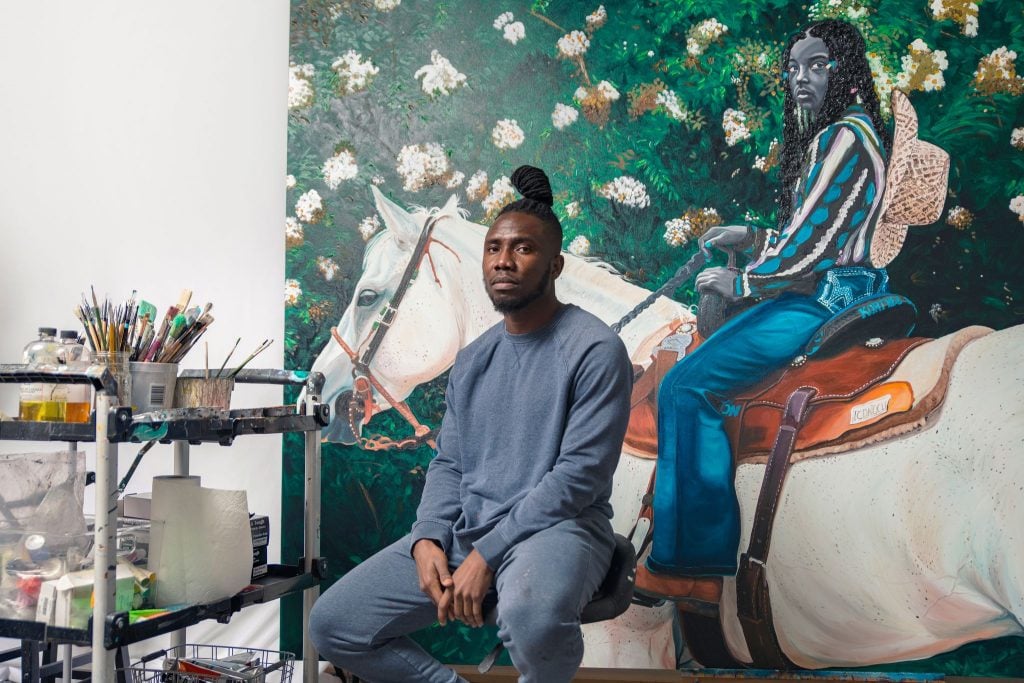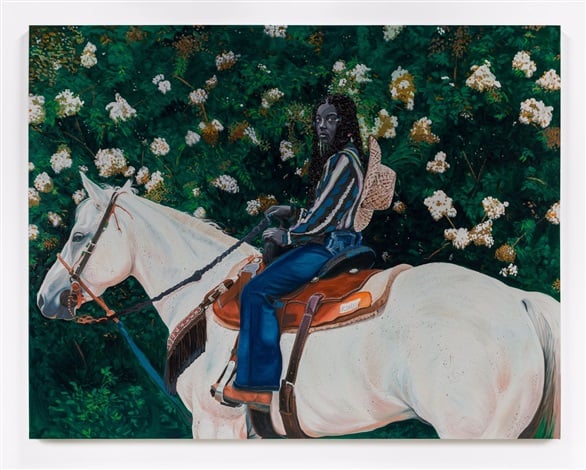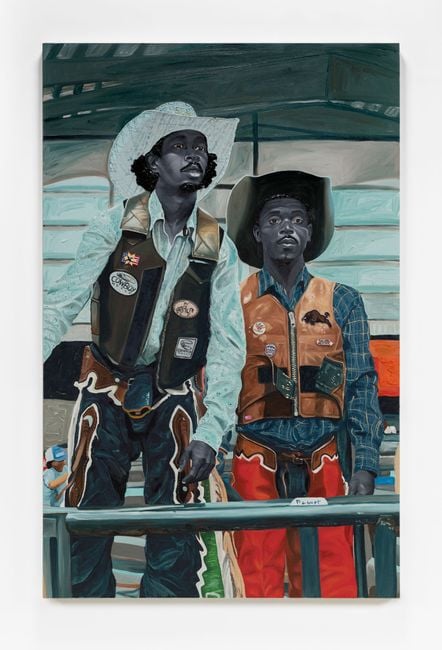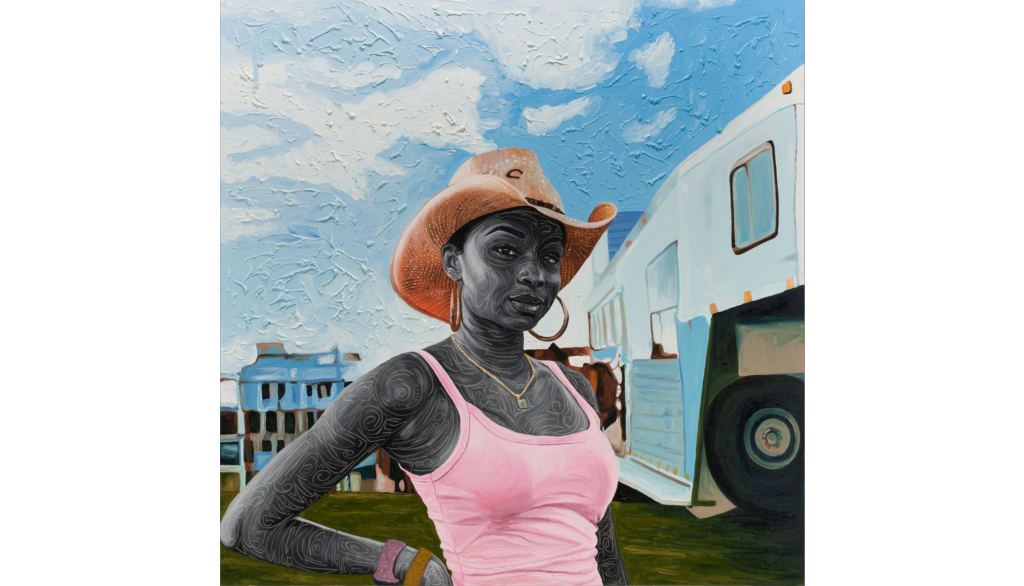Gallery Network
Artist Otis Kwame Kye Quaicoe on the Hidden Stories of Black American Cowboys That Fuel His New Paintings
The artist's ongoing series of paintings "Black Rodeo" was recently on view at Almine Rech, Brussels.

The artist's ongoing series of paintings "Black Rodeo" was recently on view at Almine Rech, Brussels.

Katie White

When Otis Kwame Kye Quaicoe was a kid growing up in Accra, Ghana, he loved to watch old Spaghetti Westerns on television or at the movie theater. “TNT movies” he called them, a nod to the station best known for its vintage cinematic offerings. Years later, he learned that the story of the American cowboy was far more nuanced than Hollywood had portrayed.

Otis Kwame Kye Quaicoe, Portrait of Kortnee Solomon on Horseback (2021). Courtesy of Almine Rech.
In 2019, Quaicoe, who now lives and works in Portland, Oregon, was watching Black Lives Matter protests unfold, when some marchers caught his eye: the Compton Cowboys, a group of Black men and women riding horses down the streets. Suddenly, Quaicoe’s vision of the all-American cowboy suddenly shifted, and the artist soon after began a years-long research project into the long-hidden history of the Black American cowboy (and cowgirl), which continues to this day through a series of portraits.
These images are bright and visceral, with Quaicoe’s stylish subjects positioned in front of colorful, sometimes patterned backgrounds. Recently, the artist debuted his works in Europe in the exhibition “Black Rodeo” at Almine Rech in Brussels. The exhibition was accompanied by a catalogue interview by Larry Ossei-Mensah.
We spoke with the artist about the hidden history of the Black American cowboy, why he finds these figures so intriguing, and the reason he probably won’t be adopting the Western lifestyle anytime soon.

Otis Kwame Kye Quaicoe, Rodeo Boys (2022). Courtesy of Almine Rech.
What was your first acquaintance with cowboys? How did you first learn about them?
I love watching movies at 12 or 13 years old and I loved Western movies, especially. In Ghana, we call them “TNT” movies. I was intrigued by how cowboys dressed and how they talk, the boots and all that. It wasn’t something I was thinking deeply about—I liked the way they’d sling a gun. It was just fun to watch and I didn’t think about it too deeply.
The movie theater was where you had one of your early encounters with art-making, wasn’t it?
I had no conception that I wanted to be an artist at that time. I wanted to be a soccer player. But hanging around the movie theater, I realized that even the posters were commissioned by artists at the time. I discovered the studio where these artists were working and that made me want to learn how to draw, really out of curiosity. Later I started to wonder if there was a school where I could learn to draw more seriously.

Otis Kwame Kye Quaicoe, Trinity (2021). Courtesy of Almine Rech.
Tell me about your discovery of Black American cowboys.
When the pandemic hit, then following the murder of George Floyd, I was going to many Black Lives Matter protests when I saw the Compton Cowboys. This is a group of Black cowboys and girls that ride together today. It hit me, like wow, there are people who look like me who are cowboys. Growing up as a child, cowboys were a fictional thing for me—like a superhero—and it really changed the way I thought about it. That was actually my first encounter with African-American cowboys and it changed something that had been about fantasy into a new reality for me.
After that experience, how did you shift into painting cowboys and cowgirls?
I began to do more research into the history of Black American cowboys, mostly online. That’s how I really came to know the whole history. As an artist, I feel a responsibility to put information out into the world, especially knowing that many people, including myself, would have no idea this history was there and still alive.
What were some of the more interesting things you learned about cowboys in general?
Well, thinking of being a kid watching these movies, I had no idea that small details, even the way a cowboy wore his bandana, had meaning, along with the color, whether it’s black, white, or red, and so on. The ways they wore their hats had meaning too. You know the bandanas were often to show allegiance, but also to conceal identity and also to protect them from the dust as they were moving from state to state.
Can you tell me a little bit about how these stories inform the work? I also know you’ve become close to the Portland-based photographer Ivan McClellan, who documents these communities of Black cowboys.
These Black Rodeo works are a combination of my imagination and reality. When I was researching African-American cowboys, I met Ivan McClennan who has become an incredible friend of mine. He self-taught photographer who has dedicated his life to photographing this culture and the phenomenon of the Black Rodeo specifically. His photographs have been a jumping-off point for some of my paintings. My interest in these Black cowboys overlapped with the pandemic so I couldn’t go out and experience these rodeos in person, and I asked Ivan to share some of his photographs with me as well as some resources for learning more about the history.

Otis Kwame Kye Quaicoe, Wright Brother (2022). Courtesy of Almine Rech.
The idea of the cowboy is rooted in ideas of the past, but through color choice and patterns and fashion choices, your portraits feel very contemporary. Can you speak to that?
My art is about the present and also the future is what I can say. I wanted to create images that capture this reality now so that hopefully in a museum in the future some kid can see a Black cowboy in the same way we look at a Renaissance painting and are able to pinpoint something of the reality of an era.
Will your “Black Rodeo” painting series continue from here?
Yes, there’s so much more to say and explore about how African-American cowboys came to exist and the separate worlds of cowboys and cowgirls. And there are so many connections to politics and how that relates to the cowboy community. There are certain aspects of history that get washed over. It’s still going on. There are cowboy movies with white actors based on the stories of Black cowboys. Why? African-Americans have played a major role in American history, but also world history, and are still shaping that future. I want to awaken the mainstream public to these stories. Black cowboys existed and they still exist today.
Last question… Do you have any plans to take up the cowboy lifestyle anytime soon?
I love horses but I am scared to get any closer to them! Probably because I’ve watched a lot of videos of people being thrown off and kicked. But I am going to try horseback riding and I’ve been invited to a lot of rodeo shows.